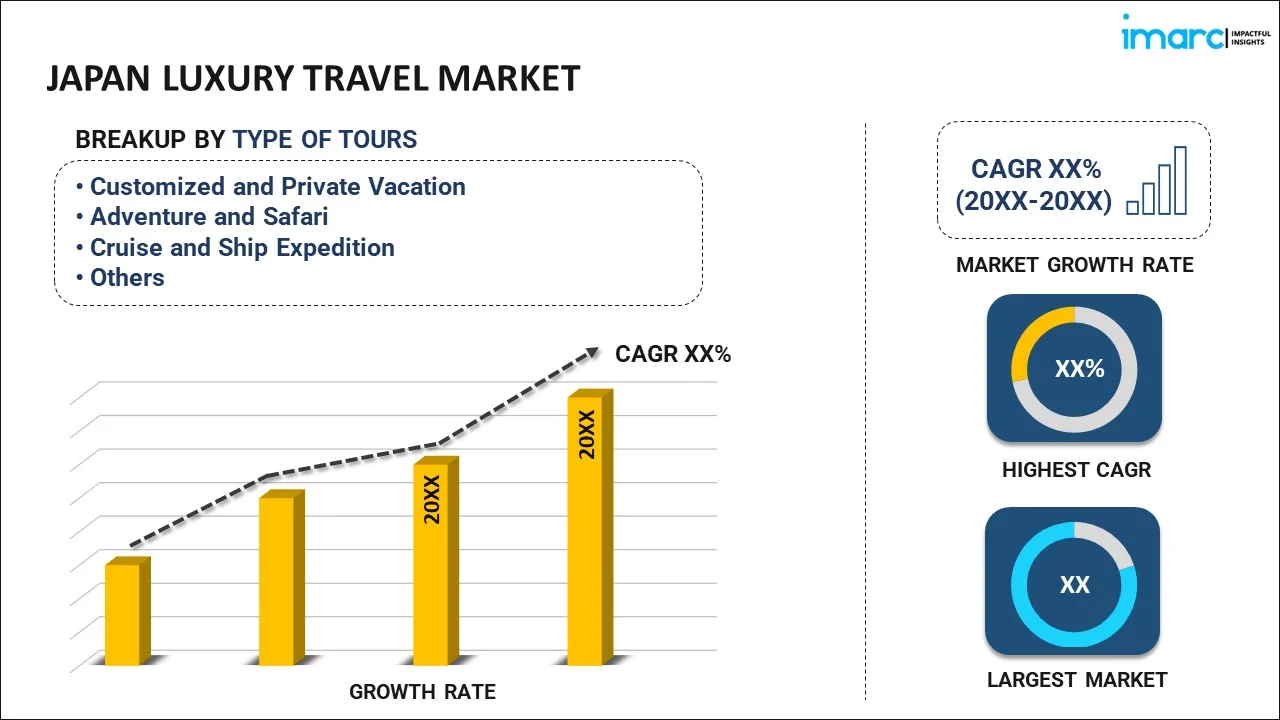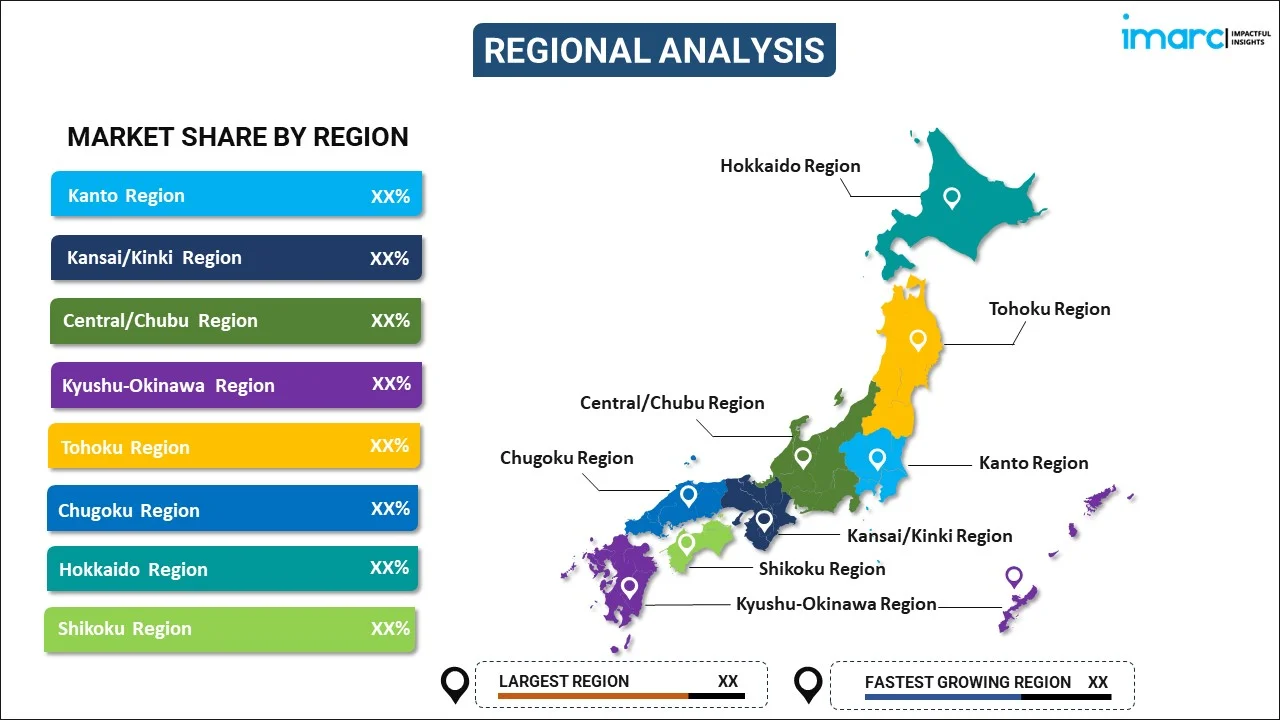
Japan Luxury Travel Market Report by Type of Tour (Customized and Private Vacation, Adventure and Safari, Cruise and Ship Expedition, Small Group Journey, Celebration and Special Event, Culinary Travel and Shopping), Age Group (Millennial (21-30), Generation X (31-40), Baby Boomers (41-60), Silver Hair (60 and above), Type of Traveller (Absolute Luxury, Aspiring Luxury, Accessible Luxury), and Region 2025-2033
Market Overview:
Japan luxury travel market size reached USD 37.1 Million in 2024. Looking forward, IMARC Group expects the market to reach USD 84.6 Million by 2033, exhibiting a growth rate (CAGR) of 8.7% during 2025-2033. The market is witnessing significant growth due to several key factors, including an increasing desire for unique and tailored travel experiences, a growing population of high-net-worth individuals (HNWIs) seeking luxury travel opportunities, and a heightened emphasis on well-being and sustainability in luxury travel offerings.
|
Report Attribute
|
Key Statistics
|
|---|---|
|
Base Year
|
2024 |
|
Forecast Years
|
2025-2033
|
|
Historical Years
|
2019-2024
|
| Market Size in 2024 | USD 37.1 Million |
| Market Forecast in 2033 | USD 84.6 Million |
| Market Growth Rate (2025-2033) | 8.7% |
Luxury travel represents an elite and exclusive segment within the tourism industry, catering to discerning individuals in search of exceptional and lavish experiences. It transcends basic amenities and comfort, instead providing bespoke services, sumptuous accommodations, gourmet culinary offerings, and distinctive, immersive activities. Luxury travel often involves stays in opulent hotels, private villas, or upscale resorts set in picturesque locales. Travelers have the opportunity to partake in spa indulgences, savor fine dining at Michelin-starred restaurants, embark on private yacht excursions, and engage in culturally enriching outings tailored to their specific interests. The hallmark of luxury travel lies in its unwavering commitment to exclusivity, meticulous attention to detail, and a dedication to delivering the utmost in comfort and satisfaction, making it the preferred choice for those in pursuit of the pinnacle of travel experiences.
Japan Luxury Travel Market Trends:
The growth of the luxury travel market in Japan during the forecast period is expected to be driven by the increasing affluence of high-net-worth individuals (HNWIs) and affluent consumers globally, expanding the clientele seeking exclusive and opulent travel experiences. These discerning travelers aspire to partake in extravagant accommodations, personalized services, and distinctive adventures. Furthermore, the growing appetite for experiential and transformative travel is serving as a catalyst for the luxury market, with travelers prioritizing immersive cultural encounters, wellness getaways, and eco-conscious journeys. Additionally, the heightened accessibility and convenience of private jet and yacht charters have amplified the allure of luxury travel, offering exclusivity and flexibility that fuel market growth. Moreover, the emergence of remote working and digital nomadism, enabling individuals to explore luxury destinations while maintaining their professional commitments, contributes to the expansion of extended-stay luxury experiences. The wellness aspect of luxury travel, emphasizing physical and mental well-being, is also prominent, with travelers seeking out spas, fitness centers, meditation retreats, and nutrition-focused experiences during their journeys. The luxury travel industry is attuned to these trends, incorporating sustainable and wellness-focused offerings into its portfolio, which in turn, is expected to bolster the regional market over the forecasted period.
Japan Luxury Travel Market Segmentation:
IMARC Group provides an analysis of the key trends in each segment of the market, along with forecasts at the country level for 2025-2033. Our report has categorized the market based on type of tour, age group, and type of traveller.
Type of Tour Insights:

To get more information on this market, Request Sample
- Customized and Private Vacation
- Adventure and Safari
- Cruise and Ship Expedition
- Small Group Journey
- Celebration and Special Event
- Culinary Travel and Shopping
The report has provided a detailed breakup and analysis of the market based on the type of tour. This includes customized and private vacation, adventure and safari, cruise and ship expedition, small group journey, celebration and special event, and culinary travel and shopping.
Age Group Insights:
- Millennial (21-30)
- Generation X (31-40)
- Baby Boomers (41-60)
- Silver Hair (60 and above)
A detailed breakup and analysis of the market based on the age group have also been provided in the report. This includes millennial (21-30), generation X (31-40), baby boomers (41-60), and silver hair (60 and above).
Type of Traveller Insights:
- Absolute Luxury
- Aspiring Luxury
- Accessible Luxury
The report has provided a detailed breakup and analysis of the market based on the type of traveller. This includes absolute luxury, aspiring luxury, and accessible luxury.
Regional Insights:

- Kanto Region
- Kansai/Kinki Region
- Central/ Chubu Region
- Kyushu-Okinawa Region
- Tohoku Region
- Chugoku Region
- Hokkaido Region
- Shikoku Region
The report has also provided a comprehensive analysis of all the major regional markets, which include Kanto Region, Kansai/Kinki Region, Central/ Chubu Region, Kyushu-Okinawa Region, Tohoku Region, Chugoku Region, Hokkaido Region, and Shikoku Region.
Competitive Landscape:
The market research report has also provided a comprehensive analysis of the competitive landscape in the market. Competitive analysis such as market structure, key player positioning, top winning strategies, competitive dashboard, and company evaluation quadrant has been covered in the report. Also, detailed profiles of all major companies have been provided.
Japan Luxury Travel Market News:
- August 2025: Restaurant operator Royal Holdings Co. is partnering with Minor Hotels, the largest hotel group in Southeast Asia, to create high-end hotel accommodations in Japan. The firm intends to launch 21 hotels throughout Japan by 2035, aiming at affluent international travelers among the over 36 million visitors annually.
- August 2025: Tokyo's skyline introduces a new emblem of sophisticated hospitality with the arrival of Fairmont Hotels and Resorts in Japan. The launch of Fairmont Tokyo encourages travelers to enjoy a unique combination of international luxury and Japanese heritage, establishing a new benchmark for premium accommodations in one of the globe’s most vibrant cities.
- July 2025: World Brands Collection Hotels & Resorts has revealed an expansion of its upscale hospitality offerings throughout Japan, collaborating with brands like Six Senses and Banyan Tree. WBC, as the hospitality division of a well-known integrated real estate development group excelling in revitalization and innovation, is influencing the future of luxury hotel management in Japan.
- July 2025: World Brands Collection Hotels and Resorts Ltd. (WBC) revealed a comprehensive enhancement of its upscale hospitality offerings throughout Japan, collaborating with renowned global brands like Six Senses and Banyan Tree. WBC, the hospitality branch of a comprehensive real estate development company and a subsidiary of Wealth Management, Inc., celebrated for its revitalization and innovation, claims to be influencing the future of luxury hotel management in Japan.
- April 2025: THRS (Travel and Hospitality Representation Services) reveals its growth into Japan and Azerbaijan. This emphasizes THRS’s commitment to crafting outstanding travel experiences for the Indian outbound sector. In this expansion, THRS has been designated as the sole sales representative for FAUCHON L’Hôtel Kyoto and Start Travel.
- January 2025: Minor International Public Company Limited (MINT), which is the parent organization of Minor Hotels, along with Royal Holdings Co., Ltd. (Royal), a prominent hotel and restaurant operator listed on the Tokyo Stock Exchange, is excited to reveal a strategic partnership. The collaboration signifies Minor Hotels' debut in Japan's vibrant luxury and lifestyle hotel sector. This collaboration establishes Royal Minor Hotels Co., Ltd., a joint venture split equally, 50/50, between Royal and Minor Hotels. This initiative seeks to provide outstanding hospitality experiences and enhance Minor Hotels’ footprint in the Japanese market. The partnership will work with top Japanese real estate companies to manage hotels under three internationally recognized Minor Hotels brands: Anantara, Avani, and Tivoli. The hotels will be established through a mix of management contracts and lease agreements, aiming for a total of 21 hotels by 2035. The joint venture Royal Minor Hotels Co., Ltd is scheduled to be officially formed in March 2025.
Japan Luxury Travel Market Report Coverage:
| Report Features | Details |
|---|---|
| Base Year of the Analysis | 2024 |
| Historical Period | 2019-2024 |
| Forecast Period | 2025-2033 |
| Units | Million USD |
| Scope of the Report | Exploration of Historical and Forecast Trends, Industry Catalysts and Challenges, Segment-Wise Historical and Predictive Market Assessment:
|
| Type of Tours Covered | Customized and Private Vacation, Adventure and Safari, Cruise and Ship Expedition, Small Group Journey, Celebration and Special Event, Culinary Travel and Shopping |
| Age Groups Covered | Millennial (21-30), Generation X (31-40), Baby Boomers (41-60), Silver Hair (60 and above) |
| Type of Travellers Covered | Absolute Luxury, Aspiring Luxury, Accessible Luxury |
| Regions Covered | Kanto Region, Kansai/Kinki Region, Central/ Chubu Region, Kyushu-Okinawa Region, Tohoku Region, Chugoku Region, Hokkaido Region, Shikoku Region |
| Customization Scope | 10% Free Customization |
| Post-Sale Analyst Support | 10-12 Weeks |
| Delivery Format | PDF and Excel through Email (We can also provide the editable version of the report in PPT/Word format on special request) |
Key Benefits for Stakeholders:
- IMARC’s industry report offers a comprehensive quantitative analysis of various market segments, historical and current market trends, market forecasts, and dynamics of the Japan luxury travel market from 2019-2033.
- The research report provides the latest information on the market drivers, challenges, and opportunities in the Japan luxury travel market.
- Porter's five forces analysis assist stakeholders in assessing the impact of new entrants, competitive rivalry, supplier power, buyer power, and the threat of substitution. It helps stakeholders to analyze the level of competition within the Japan luxury travel industry and its attractiveness.
- Competitive landscape allows stakeholders to understand their competitive environment and provides an insight into the current positions of key players in the market.
Key Questions Answered in This Report
The luxury travel market in Japan was valued at USD 37.1 Million in 2024.
The Japan luxury travel market is projected to exhibit a CAGR of 8.7% during 2025-2033, reaching a value of USD 84.6 Million by 2033.
Key factors driving Japan's luxury travel market include a growing affluent population, strong demand for unique cultural and historical experiences, high-quality service standards, advanced infrastructure, and increasing interest from international high-net-worth individuals. Additionally, Japan's appeal as a safe, clean, and technologically advanced destination further boosts luxury tourism.
Need more help?
- Speak to our experienced analysts for insights on the current market scenarios.
- Include additional segments and countries to customize the report as per your requirement.
- Gain an unparalleled competitive advantage in your domain by understanding how to utilize the report and positively impacting your operations and revenue.
- For further assistance, please connect with our analysts.
 Request Customization
Request Customization
 Speak to an Analyst
Speak to an Analyst
 Request Brochure
Request Brochure
 Inquire Before Buying
Inquire Before Buying




.webp)




.webp)












